Mineral Composition of Soil and the Wheat Grain in Intensive and Conservation Cropping Systems
Abstract
1. Introduction
2. Materials and Methods
2.1. Study Site
2.2. Experimental Design
2.3. Samples Preparation and Chemical Analyses
2.3.1. Soil Sampling
2.3.2. Grain Sampling
2.3.3. Chemical Analysis
2.4. Bioaccumulation Factor
2.5. Statistical Analysis
3. Results
3.1. Effects of Cropping Systems on Soil Elemental Composition
3.2. Effects of Cropping Systems on Grain Elemental Composition
3.3. The Element Bioaccumulation in Wheat Grain from Different Cropping Systems and Cultivars
3.4. Principal Component Analysis for ICS and CCS Impact on Elemental Composition of Soil and Grain and BAF
3.5. Productivity Parameters and Dependence between Grain Yield and BAF
4. Discussion
5. Conclusions
Author Contributions
Funding
Institutional Review Board Statement
Informed Consent Statement
Data Availability Statement
Acknowledgments
Conflicts of Interest
Appendix A
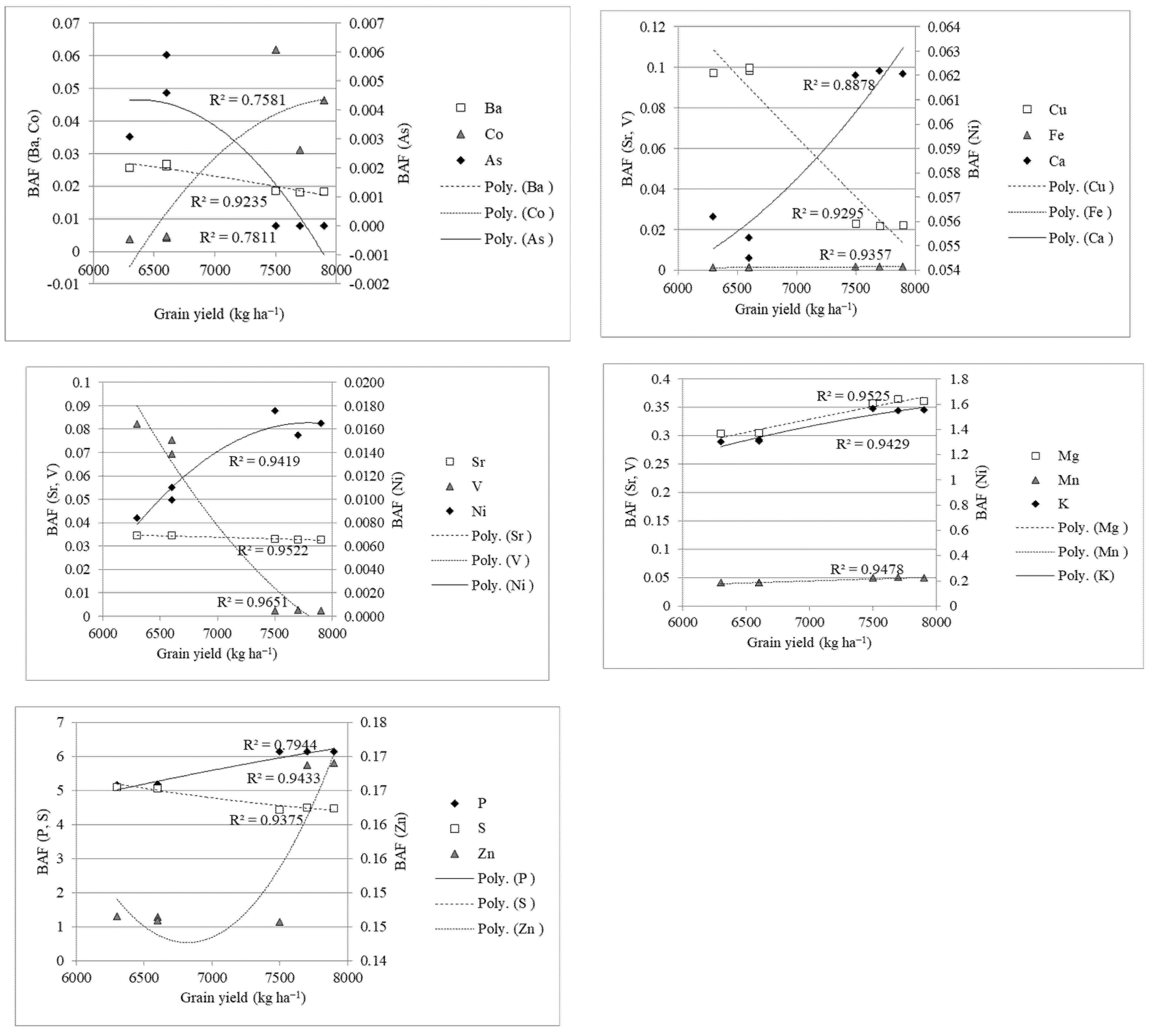

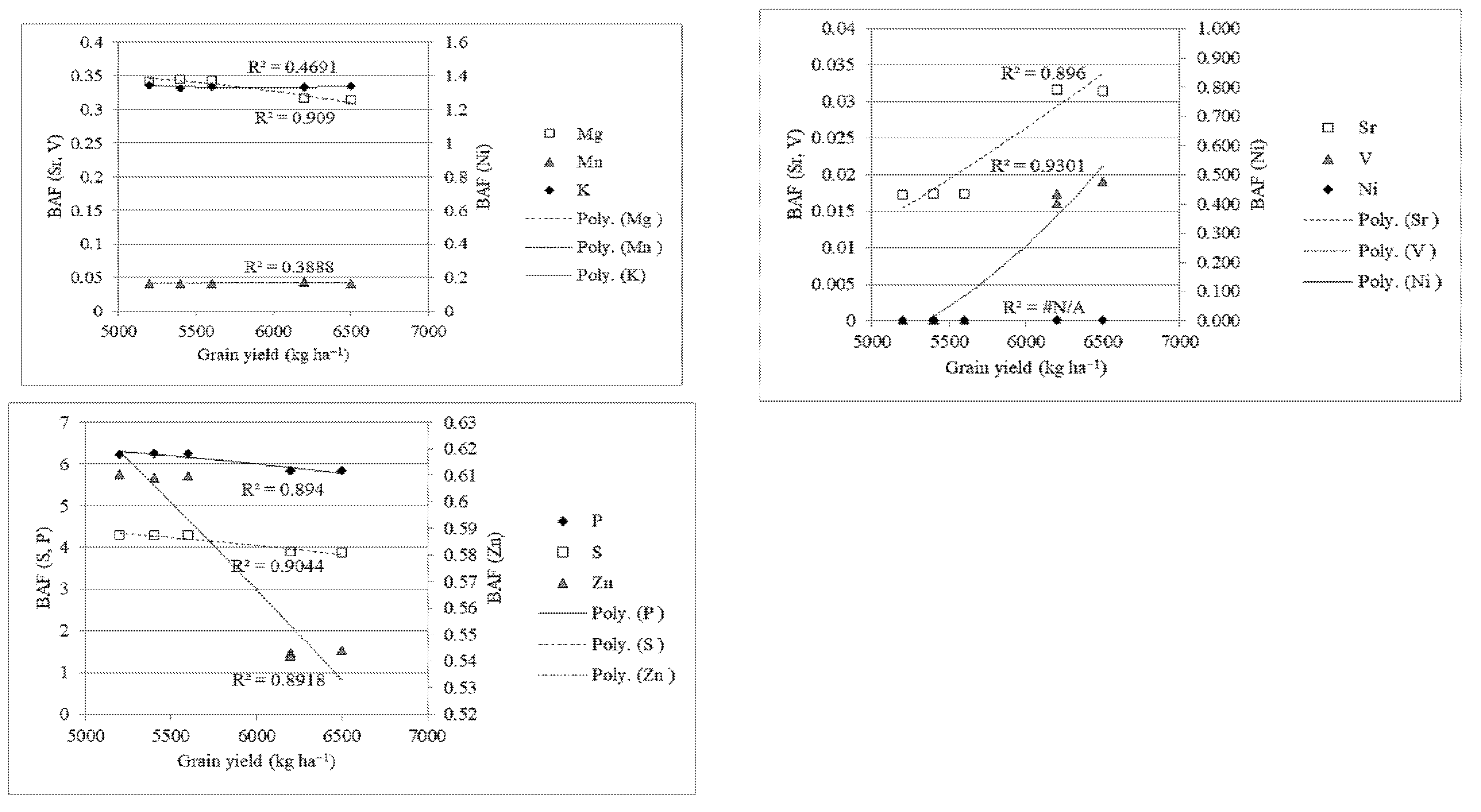
References
- RoljevićNikolić, S.; Vuković, P.; Sarić, R. Climate Changes and Sustainable Management of Natural Resources: Challenges for Agriculture. In Research Anthology on Environmental and Societal Impacts of Climate Change; Khosrow-Pour, M., Ed.; IGI Global: Hershey, PA, USA, 2022; pp. 1932–1943. [Google Scholar] [CrossRef]
- Aryal, J.P.; Sapkota, T.B.; Khurana, R.; Khatri-Chhetri, A.; Rahut, D.B.; Jat, M.L. Climate change and agriculture in South Asia: Adaptation options in smallholder production systems. Environ. Dev. Sustain. 2020, 22, 5045–5075. [Google Scholar] [CrossRef]
- Praveen, B.; Talukdar, S.; Mahato, S.; Mondal, J.; Sharma, P.; Islam, A.R.M.; Rahman, A. Analyzing trend and forecasting of rainfall changes in India using non-parametrical and machine learning approaches. Sci. Rep. 2020, 10, 10342. [Google Scholar] [CrossRef] [PubMed]
- Sharma, S.; Schulthess, A.W.; Bassi, F.M.; Badaeva, E.D.; Neumann, K.; Graner, A.; Özkan, H.; Werner, P.; Knüpffer, H.; Kilian, B. Introducing Beneficial Alleles from Plant Genetic Resources into the Wheat Germplasm. Biology 2021, 10, 982. [Google Scholar] [CrossRef] [PubMed]
- Trnka, M.; Olesen, J.E.; Kersebaum, K.C.; Skjelvåg, A.O.; Eitzinger, J.; Seguin, B.; Peltonen-Sainio, P.; Rötter, R.; Iglesias, A.; Orlandini, S.; et al. Agroclimatic conditions in Europe under climate change. Glob. Chang. Biol. 2011, 17, 2298–2318. [Google Scholar] [CrossRef]
- Lobell, D.B.; Schlenker, W.; Costa-Roberts, J. Climate Trends and Global Crop Production Since 1980. Science 2011, 333, 616–620. [Google Scholar] [CrossRef]
- Pinke, Z.; Lovei, G.L. Increasing temperature cuts back crop yields in Hungary over the last 90 years. Glob. Chang. Biol. 2017, 23, 5426–5435. [Google Scholar] [CrossRef]
- Ludajić, G.I.; Pezo, L.L.; Filipović, J.S.; Filipović, V.S.; Kosanić, N.Ž. Determination of essential and toxic elements in products of milling wheat. Hem. Ind. 2016, 70, 707–715. [Google Scholar] [CrossRef]
- Jakobsone, I.; Kantāne, I.; Zute, S.; Jansone, I.; Bartkevičs, V. Macro-elements and trace elements in cereal grains cultivated in Latvia. Sect. B Nat. Exact Appl. Sci. 2015, 69, 152–157. [Google Scholar] [CrossRef]
- Kan, A. Characterization of the fatty acid and mineral compositions of selected cereal cultivars from Turkey. Rec. Nat. Prod. 2015, 9, 124. [Google Scholar]
- Sithole, N.J.; Magwaza, L.S. Long-term changes of soil chemical characteristics and maize yield in no-till conservation agriculture in a semi-arid environment of South Africa. Soil Tillage Res. 2019, 194, 104317. [Google Scholar] [CrossRef]
- Šeremešić, S.; Ćirić, V.; Djalović, I.; Vasin, J.; Zeremski, T.; Siddique, K.H.; Farooq, M. Long-term winter wheat cropping influenced soil organic carbon pools in different aggregate fractions of Chernozem soil. Arch. Agron. Soil Sci. 2020, 66, 2055–2066. [Google Scholar] [CrossRef]
- Chivenge, P.P.; Murwira, H.K.; Giller, K.E.; Mapfumo, P.; Six, J. Long-term impact of reduced tillage and residue management on soil carbon stabilization: Implications for conservation agriculture on contrasting soils. Soil Tillage Res. 2007, 94, 328–337. [Google Scholar] [CrossRef]
- Lal, R. Soil carbon sequestration impacts on global climate change and food security. Science 2004, 304, 1623–1627. [Google Scholar] [CrossRef] [PubMed]
- Lal, R. Sequestering carbon and increasing productivity by conservation agriculture. J. Soil Water Conserv. 2015, 70, 55A–62A. [Google Scholar] [CrossRef]
- Gonzalez-Sanchez, E.J.; Ordonez-Fernandez, R.; Carbonell-Bojollo, R.; Veroz-Gonzalez, O.; Gil-Ribes, J.A. Meta-analysis on atmospheric carbon capture in Spain through the use of conservation agriculture. Soil Tillage Res. 2012, 122, 52–60. [Google Scholar] [CrossRef]
- Olson, K.R. Soil organic carbon sequestration, storage, retention and loss in U.S. croplands: Issues paper for protocol development. Geoderma 2013, 195–196, 201–206. [Google Scholar] [CrossRef]
- Six, J.; Feller, C.; Denef, K.; Ogle, S.M.; de Moraes, J.C.; Albrecht, A. Soil organic matter, biota and aggregation in temperate and tropical soils—effects of no-tillage. Agronomie 2002, 22, 755–775. [Google Scholar] [CrossRef]
- Six, J.; Conant, R.T.; Paul, E.A.; Paustian, K. Stabilization mechanisms for soil organic matter: Implications for C saturation of soils. Plant Soil 2002, 141, 155–176. [Google Scholar] [CrossRef]
- Page, K.L.; Dang, Y.P.; Dalal, R.C. The ability of conservation agriculture to conserve soil organic carbon and the subsequent impact on soil physical, chemical, and biological properties and yield. Front. Sustain. Food Syst. 2020, 4, 31. [Google Scholar] [CrossRef]
- Martinez, J.M.; Galantini, J.A.; Duval, M.E.; Lopez, F.M. Soil quality assessment based on soil organic matter pools under long-term tillage systems and following tillage conversion in a semi humid region. Soil Use Manag. 2020, 36, 400–409. [Google Scholar] [CrossRef]
- Elrashidi, M.; Wysocki, D.; Schoeneberger, P. Effects of land use on selected properties and heavy metal concentration for soil in the US Great Plains. Commun. Soil Sci. Plant Anal. 2016, 47, 2465–2478. [Google Scholar] [CrossRef]
- Chang, T.J.; Cui, X.Q.; Ruan, Z.; Zhao, X.L. Long-term effects of tillage methods on heavy metal accumulation and availability in purple paddy soil. Huanjing Kexue 2014, 35, 2381–2391. [Google Scholar] [PubMed]
- Jug, I.; Jug, D.; Kovačević, D.; Đurđević, B.; Stipešević, B. Heavy metals concentration in soybean as affected by different tillage systems in Baranja region. In Proceedings of the Sixth International Scientific Agricultural Symposium “Agrosym 2015”, Jahorina, Bosnia, 15–18 October 2015; pp. 107–112. [Google Scholar]
- Tang, W.; Xiao, X.; Zhang, H.; Huang, G.; Tang, H.; Li, C.; Liu, S.; Wang, K. Effects of rotational tillage on nutrient storage capacity and Cd content in tilth soil of double-cropping rice region. Acta Agron. Sin. 2018, 44, 105–114. [Google Scholar] [CrossRef]
- Jaja, N.; Mbila, M.; Codling, E.E.; Reddy, S.S.; Reddy, C.K. Trace metal enrichment and distribution in a poultry litter-amended soil under different tillage practices. Open Agric. 2013, 7, 88–95. [Google Scholar] [CrossRef][Green Version]
- Kobierski, M.; Jaskulska, I.; Jaskulski, D.; Debska, B. Effect of a tillage system on the chemical properties of sandy loam soils. J. Elem. 2020, 5, 1463–1473. [Google Scholar] [CrossRef]
- Veiga, A.; Carla Ferreira, C.; Boulet, A.K.; Caetano, A.; Gonzalez-Pelayo, Ó.; Abrantes, N.; Keizer, J.; Ferreira, A. Assessment of total and available heavy metal contents in vineyards managed under different agriculture practices. In Proceedings of the 22nd EGU General Assembly Conference Abstracts, Held Online, 4–8 May 2020. [Google Scholar] [CrossRef]
- Wozniak, A.; Rachon, L. Effect of tillage systems on the yield and quality of winter wheat grain and soil properties. Agriculture 2020, 10, 405. [Google Scholar] [CrossRef]
- Woźniak, A.; Stępniewska, A. Yield and quality of durum wheat grain in different tillage systems. J. Elem. 2017, 22, 817–829. [Google Scholar] [CrossRef]
- Yousefian, M.; Shahbazi, F.; Hamidian, K. Crop Yield and Physicochemical Properties of Wheat Grains as Affected by Tillage Systems. Sustainability 2021, 13, 4781. [Google Scholar] [CrossRef]
- Buczek, J. Quality and productivity of hybrid wheat depending on the tillage practices. Plant Soil Environ. 2020, 66, 415–420. [Google Scholar] [CrossRef]
- Korunović, R.; Stojanović, S. Practicum in Pedology; Faculty of Agriculture: Belgrade, Serbia, 1989. [Google Scholar]
- Popović Djordjević, J.; Marjanović, Ž.S.; Gršić, N.; Adžić, T.; Popović, B.; Bogosavljević, J.; Brčeski, I. Essential elements as a distinguishing factor between mycorrhizal potentials of two cohabiting truffle species in riparian forest habitat in Serbia. Chem. Biodivers. 2019, 16, e1800693. [Google Scholar] [CrossRef]
- Bhatti, S.S.; Sambyal, V.; Nagpal, A.K. Analysis of genotoxicity of agricultural soils and metal (Fe, Mn and Zn) accumulation in crops. Int. J. Environ. Res. 2018, 12, 439–449. [Google Scholar] [CrossRef]
- Guttières, R.; Nunan, N.; Raynaud, X.; Lacroix, G.; Barot, S.; Barré, P.; Giraldin, C.; Guenet, B.; Lata, J.C.; Abbadie, L. Temperature and soil management effects on carbon fluxes and priming effect intensity. Soil Biol. Biochem. 2021, 153, 108103. [Google Scholar] [CrossRef]
- Neugschwandtner, R.W.; Száková, J.; Pachtrog, V.; Tlustos, P.; Cerny, J.; Kulhánek, M.; Kaul, H.P.; Eutenauer, P.; Moitzi, G.; Wagentristi, H. Basic soil chemical properties after 15 years in a long-term tillage and crop rotation experiment. Int. Agrophys. 2020, 34, 133–140. [Google Scholar] [CrossRef]
- Li, Y.; Li, Z.; Cui, S.; Jagadamma, S.; Zhang, Q. Residue retention and minimum tillage improve physical environment of the soil in croplands: A global meta-analysis. Soil Tillage Res. 2019, 194, 104292. [Google Scholar] [CrossRef]
- Limousin, G.; Tessier, D. Effects of no-tillage on chemical gradients and topsoil acidification. Soil Tillage Res. 2007, 92, 167–174. [Google Scholar] [CrossRef]
- Cooper, J.; Sanderson, R.; Cakmak, I.; Ozturk, L.; Shotton, P.; Carmichael, A.; Haghighi, R.S.; Tetard-Jones, C.; Volakais, N.; Eyre, M.; et al. Effect of organic and conventional crop rotation, fertilization, and crop protection practices on metal contents in wheat (Triticumaestivum). J. Agric. Food Chem. 2011, 59, 4715–4724. [Google Scholar] [CrossRef]
- BelanovićSimić, S.; Čakmak, D.; Beloica, J.; ObratovPetković, D.; Kadović, R.; Miljković, P.; Lukić, S.; Marković, Đ. Bioaccumulation of Pb and Cd in soils of meadow associations Agrostietumcapillaris (Z. Pavlović 1955): On Zlatar and Staraplanina. ZemljišteBiljka 2017, 66, 1–14. [Google Scholar]
- Dolijanović, Ž.; Roljević-Nikolić, S.; Kovačević, D.; Djurdjić, S.; Miodragović, R.; JovanovićTodorović, M.; Popović-Djordjević, J. Mineral profile of the winter wheat grain: Effects of soil tillage systems and nitrogen fertilization. Appl. Ecol. Environ. Res. 2019, 17, 11757–11771. [Google Scholar] [CrossRef]
- Jatav, H.S.; Sharma, L.D.; Sadhukhan, R.; Singh, S.K.; Singh, S.; Rajput, V.D.; Parihar, M.; Jatav, S.S.; Jinger, D.; Kumar, S. An Overview of Micronutrients: Prospects and Implication in Crop Production. In Plant Micronutrients: Deficiency and Toxicity Management; Aftab, T., Hakeem, K.R., Eds.; Springer Nature: Cham, Switzerland, 2020; pp. 1–30. [Google Scholar] [CrossRef]
- Manojlović, M.; Bogdanović, D.; Čabilovski, R.; Marijanušić, K. The status of trace elements in soils on organic and conventional farms in Serba. Mech. Agric. Conserv. Resour. 2016, 4, 12–14. [Google Scholar]
- Pankhurst, C.E.; Kirby, J.M.; Hawke, B.G.; Harch, B.D. Impact of a change in tillage and crop residue management practice on soil chemical and microbiological properties in a cereal-producing red duplex soil in NSW, Australia. Biol. Fertil. Soils 2002, 35, 189–196. [Google Scholar] [CrossRef]
- Ciolek, A.; Makarska, E.; Wesolowski, M.; Cierpiala, R. Content of selected nutrients in wheat, barley and oat grain from organic and conventional farming. J. Elem. 2012, 17, 181–189. [Google Scholar] [CrossRef]
- Ryan, M.H.; Derrick, J.W.; Dann, P.R. Grain mineralconcentrations and yield of wheat grown under organic and conven-tional management. J. Sci. Food Agric. 2004, 84, 207–216. [Google Scholar] [CrossRef]
- Dang, Y.P.; Seymour, N.P.; Walker, S.R.; Bell, M.J.; Freebairn, D.M. Strategic tillage in no-till farming systems in Australia’s northern grains-growing regions: I. Drivers and implementation. Soil Tillage Res. 2015, 152, 104–114. [Google Scholar] [CrossRef]
- Jahangir, M.M.R.; Islam, S.; Nitu, T.T.; Uddin, S.; Kabir, A.K.M.A.; Meah, M.B.; Islam, R. Bio-Compost-Based Integrated Soil Fertility Management Improves Post-Harvest Soil Structural and Elemental Quality in a Two-Year Conservation Agriculture Practice. Agronomy 2021, 11, 2101. [Google Scholar] [CrossRef]
- Balabanova, B.; Stafilov, T. Bio-Accumulation of Essential and Heavy Metals in Plant Food—Multielements Characterization of Plant Food; Lap Lambert Academic Publishing: Saarbrücken, Germany, 2017. [Google Scholar]
- Pandino, G.; Mattiolo, E.; Lombardo, S.; Lombardo, G.M.; Mauromicale, G. Organic cropping system affects grain chemical composition, rheological and agronomic performance of durum wheat. Agriculture 2020, 10, 46. [Google Scholar] [CrossRef]
- Cooper, H.V.; Sjögersten, S.; Lark, R.M.; Mooney, S.J. To till or not to till in a temperate ecosystem? Implications for climate change mitigation. Environ. Res. Lett. 2021, 16, 054022. [Google Scholar] [CrossRef]
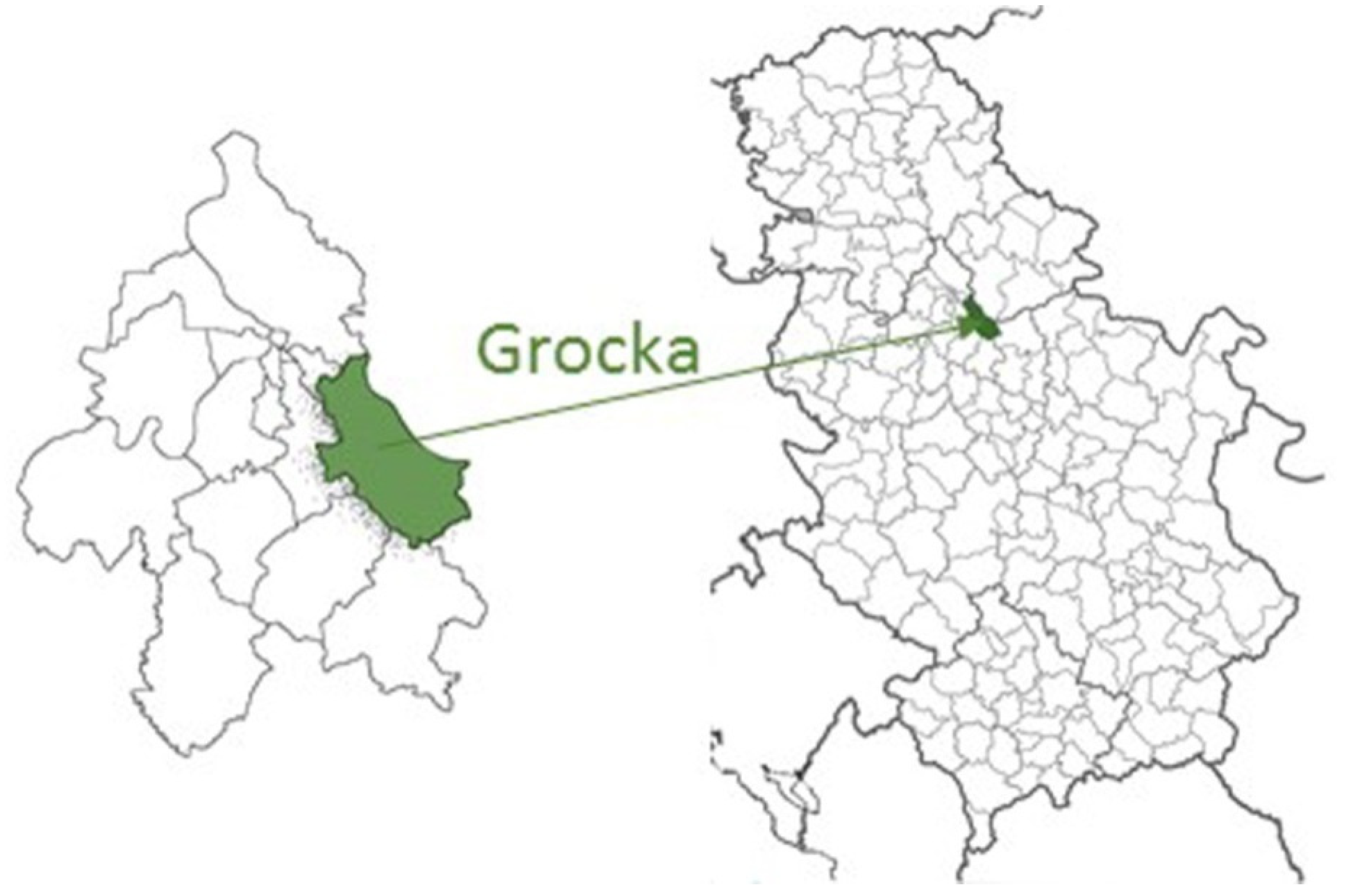
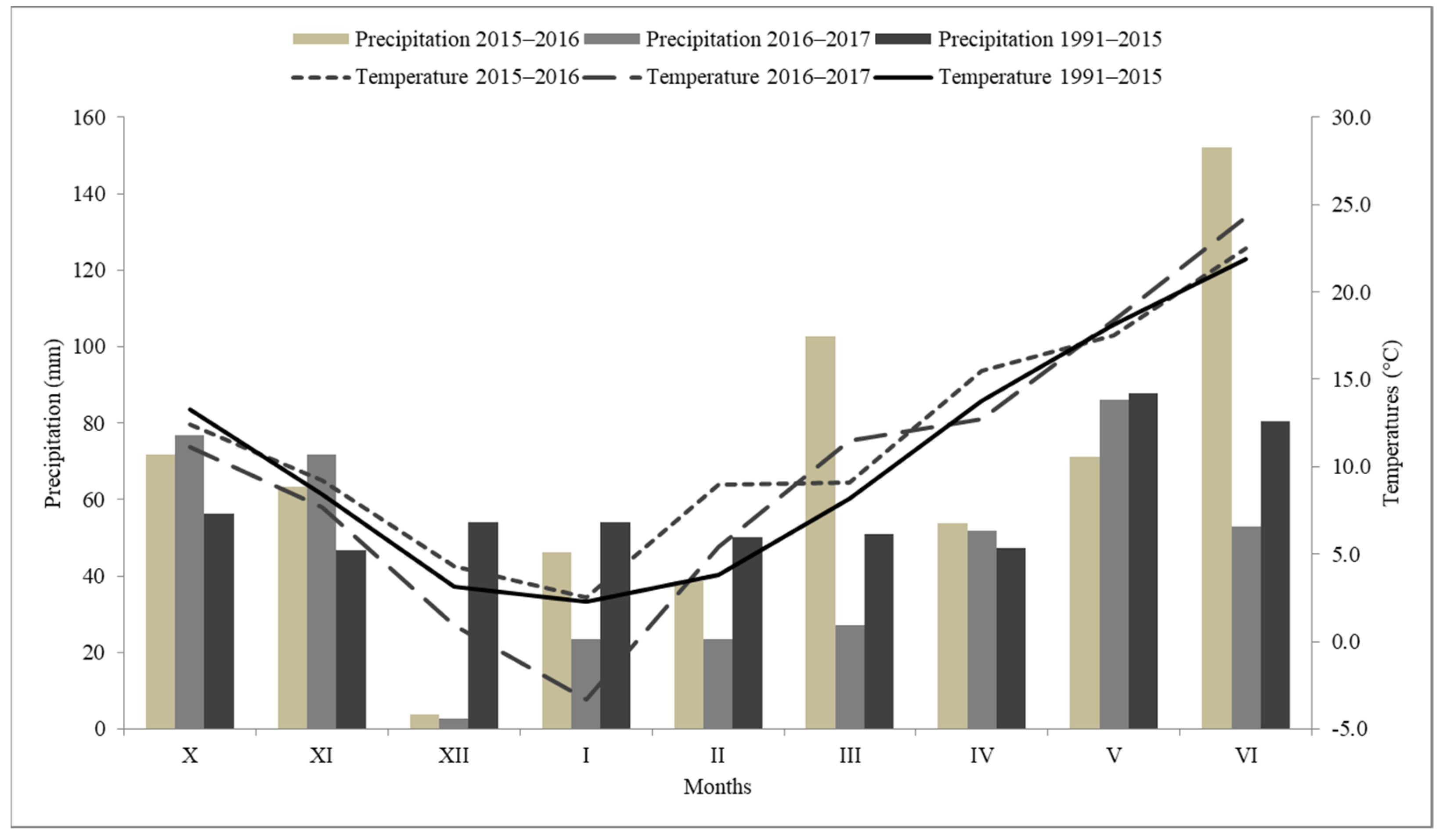
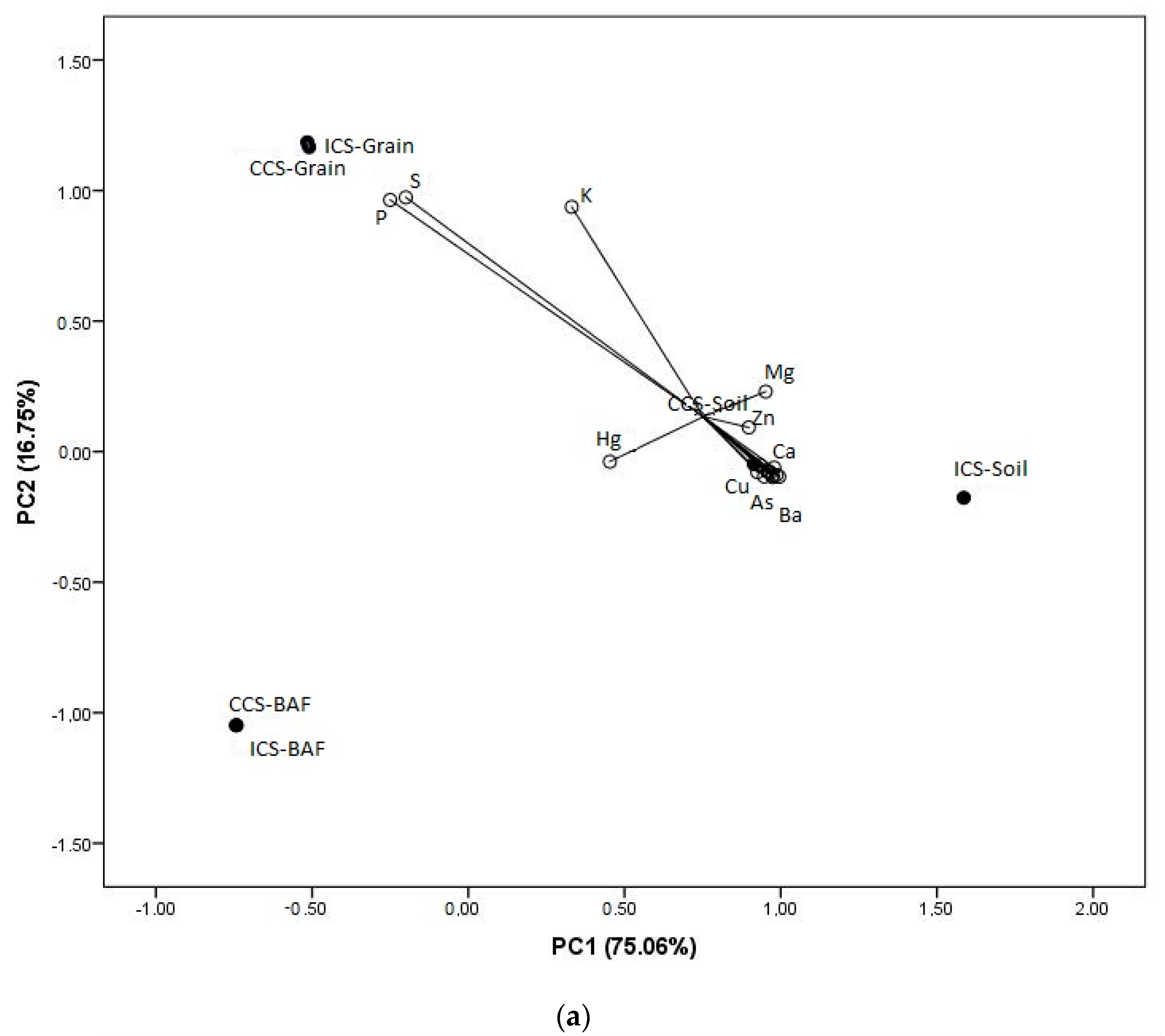
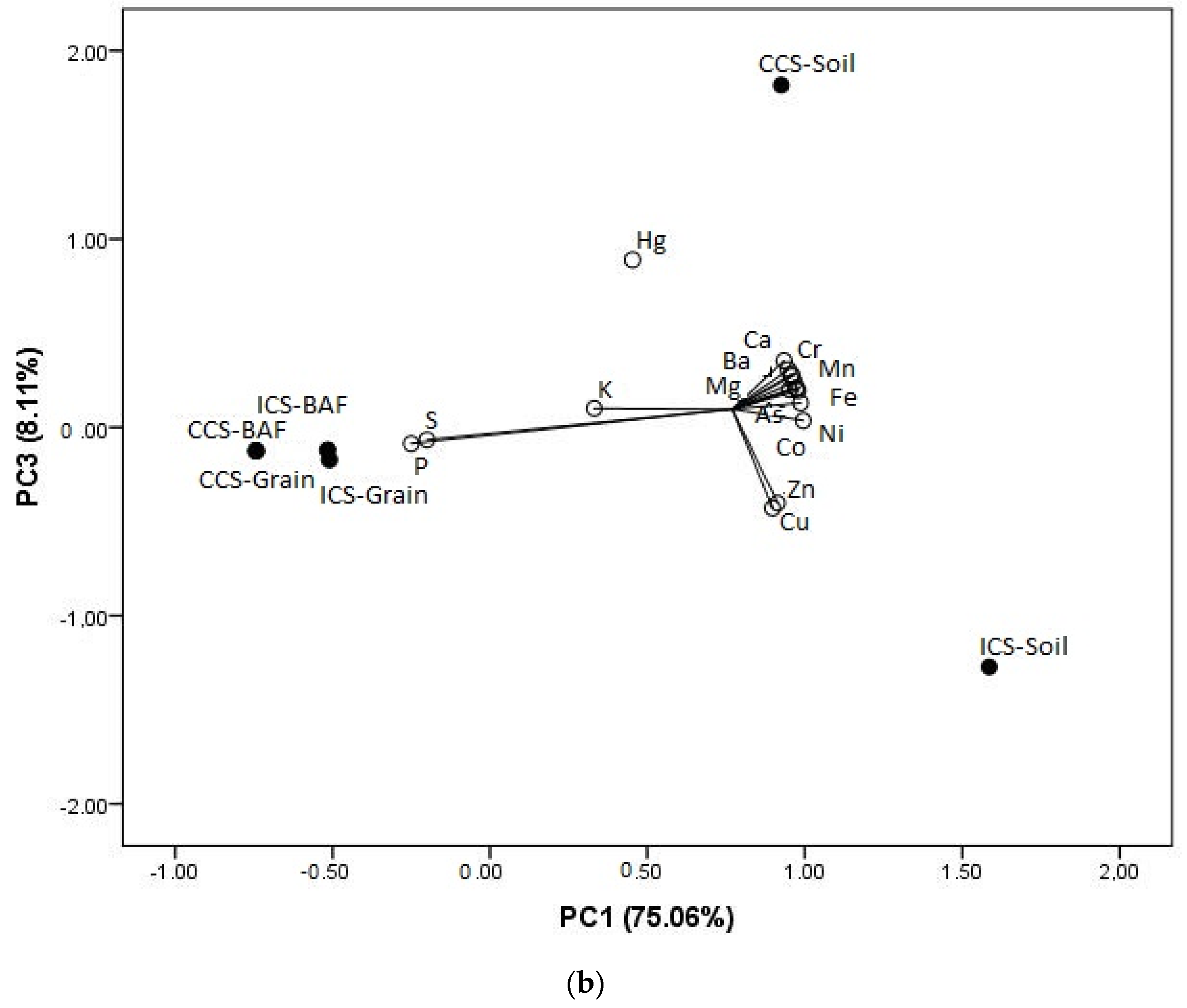
| Soil Characteristics | Intensive Cropping System | Conservation Cropping System | ANOVA | ||
|---|---|---|---|---|---|
| F | p | LSD(0.05) | |||
| pH in H2O | 8.03 ± 0.6 | 7.91 ± 0.5 | 0.060 | 0.819 | - |
| pH in KCl | 7.24 ± 0.4 | 7.13 ± 0.3 | 0.113 | 0.753 | - |
| N available (kg ha−1) | 34.30 ± 3.5 | 35.00 ± 3.6 | 0.060 | 0.819 | - |
| CaCO3 (%) | 1.40 ± 0.01 | 1.52 ± 0.02 | 0.120 | 0.784 | - |
| Organic matter (%) | 3.26 ± 0.25 | 3.30 ± 0.26 | 0.038 | 0.854 | - |
| Total content of macroelements in the soil (mg kg−1) | |||||
| Mean ± S.D. | F | p | LSD (0.05) | ||
| Ca | 2577 ± 52 | 3283 ± 52 | 276.50 | 0.000 | 0.009 |
| K | 2114 ± 16 | 2369 ± 23 | 248.50 | 0.000 | 0.010 |
| Mg | 3113 ± 62 | 3130 ± 42 | 0.15 | 0.714 | - |
| P | 640 ± 2 | 622 ± 2 | 121.50 | 0.000 | 0.021 |
| S | 224 ± 2 | 236.7 ± 0.8 | 104.28 | 0.001 | 0.024 |
| Total content of microelements in the soil (mg kg−1) | |||||
| Mean ± S.D. | F | p | LSD (0.05) | ||
| As | 5.2 ± 0.4 | 5.19 ± 0.03 | 0.002 | 0.968 | - |
| Ba | 70.7 ± 0.2 | 74.2 ± 0.3 | 282.69 | 0.000 | 0.009 |
| Co | 12.89 ± 0.03 | 11.83 ± 0.006 | 8266.78 | 0.000 | 0.000 |
| Cu | 62.09 ± 0.5 | 17.1 ± 0.2 | 142,877.65 | 0.000 | 0.000 |
| Cr | 13.85 ± 0.42 | 16.28 ± 0.548 | 36.93 | 0.004 | 0.064 |
| Fe | 17,050 ± 138 | 16,857 ± 88 | 4.17 | 0.111 | - |
| Hg | <LOD | 0.04 ± 0.02 | 11.08 | 0.029 | 0.179 |
| Mn | 464 ± 6 | 452 ± 3 | 9.60 | 0.036 | 0.199 |
| Ni | 38.10 ± 0.3 | 28.4 ± 0.2 | 6901.47 | 0.000 | 0.000 |
| Sr | 12.59 ± 0.06 | 14.15 ± 0.06 | 1014.00 | 0.000 | 0.003 |
| V | 19 ± 2 | 21 ± 2 | 1.50 | 0.288 | - |
| Zn | 157.3 ± 2 | 44.8 ± 0.2 | 474,609.37 | 0.000 | 0.000 |
| Elements | Intensive Cropping System | Average | Conservation Cropping System | Average | ||
|---|---|---|---|---|---|---|
| “Ilina” | “Zvezdana” | “Ilina” | “Zvezdana” | |||
| Mean ± S.D. | Mean ± S.D. | |||||
| Concentration (mg kg−1) macroelements | ||||||
| Ca | 160 ± 3 | 142.6 ± 0.8 | 151.3 | 129 ± 5 | 130 ± 3 | 129.50 |
| K | 3282 ± 45 | 2759 ± 40 | 3020.50 | 3158 ± 21 | 3163 ± 12 | 3160.50 |
| Mg | 1124 ± 11 | 948 ± 22 | 1036.00 | 988 ± 18 | 1075 ± 18 | 1031.50 |
| P | 3923 ± 9 | 3303 ± 12 | 3613.00 | 3636 ± 13 | 3889 ± 18 | 3762.50 |
| S | 1002.4 ± 0.8 | 1141 ± 5 | 1071.70 | 922 ± 5 | 1015 ± 4 | 968.50 |
| Concentration (mg kg−1) microelements | ||||||
| As | <LOD | 0.02 ± 0.009 | 0.01 | 0.17 ± 0.003 | 0.17 ± 0.003 | 0.17 |
| Ba | 1.30 ± 0.02 | 1.85 ± 0.04 | 1.57 | 1.07 ± 0.010 | 1.29 ± 0.02 | 1.18 |
| Co | 0.6 ± 0.2 | 0.05 ± 0.006 | 0.33 | 0.01 ± 0.002 | 0.02 ± 0.002 | 0.02 |
| Cu | 1.38 ± 0.04 | 6.11 ± 0.08 | 3.74 | 1.28 ± 0.06 | 2.52 ± 0.09 | 1.90 |
| Fe | 26.8 ± 0.4 | 20.9 ± 0.3 | 23.85 | 38.3 ± 0.6 | 19.7 ± 0.2 | 29.00 |
| Mn | 22.8 ± 0.2 | 18.7 ± 0.3 | 20.75 | 19.2 ± 0.5 | 18.82 ± 0.10 | 19.01 |
| Ni | 0.63 ± 0.04 | 0.37 ± 0.05 | 0.50 | <LOD | <LOD | - |
| Sr | 0.41 ± 0.004 | 0.43 ± 0.002 | 0.42 | 0.45 ± 0.003 | 0.25 ± 0.002 | 0.35 |
| V | 0.046 ± 0.004 | 1.43 ± 0.03 | 0.74 | 0.36 ± 0.004 | <LOD | 0.18 |
| Zn | 26.58 ± 0.10 | 23.02 ± 0.02 | 24.80 | 24.33 ± 0.06 | 27.32 ± 0.10 | 25.82 |
| Elements | Cropping System | Cultivar | Cropping System × Cultivar | ||||||
|---|---|---|---|---|---|---|---|---|---|
| F | p | LSD (0.05) | F | p | LSD (0.05) | F | p | LSD (0.05) | |
| Concentration (mg kg−1) macroelements | |||||||||
| Ca | 130.68 | 0.000 | 3.468 | 18.49 | 0.003 | 3.468 | 23.27 | 0.001 | 5.664 |
| K | 55.87 | 0.000 | 34.064 | 191.20 | 0.000 | 34.064 | 198.66 | 0.000 | 55.627 |
| Mg | 0.19 | 0.671 | - | 18.96 | 0.002 | 18.584 | 165.61 | 0.000 | 30.347 |
| P | 300.98 | 0.000 | 15.497 | 455.35 | 0.000 | 15.497 | 2604.01 | 0.000 | 25.307 |
| S | 1917.81 | 0.000 | 4.286 | 2414.70 | 0.000 | 4.286 | 93.61 | 0.000 | 6.999 |
| Concentration (mg kg−1) microelements | |||||||||
| As | 2949.82 | 0.000 | 0.005 | 20.48 | 0.002 | 0.005 | 14.67 | 0.005 | 0.009 |
| Ba | 748.92 | 0.000 | 0.16 | 711.48 | 0.000 | 0.16 | 130.68 | 0.000 | 0.260 |
| Co | 28.61 | 0.001 | 0.05 | 21.52 | 0.002 | 0.05 | 22.99 | 0.001 | 0.082 |
| Cu | 2073.52 | 0.000 | 0.074 | 5427.55 | 0.000 | 0.074 | 1854.84 | 0.000 | 0.120 |
| Fe | 489.65 | 0.000 | 0.423 | 2770.38 | 0.000 | 0.423 | 744.41 | 0.000 | 0.691 |
| Mn | 93.16 | 0.000 | 0.328 | 154.39 | 0.000 | 0.328 | 106.45 | 0.000 | 0.535 |
| Ni | 731.71 | 0.000 | 0.034 | 49.46 | 0.000 | 0.034 | 49.46 | 0.000 | 0.055 |
| Sr | 2100.36 | 0.000 | 0.003 | 2945.45 | 0.000 | 0.003 | 4480.36 | 0.000 | 0.005 |
| V | 3987.45 | 0.000 | 0.016 | 3355.50 | 0.000 | 0.016 | 9824.06 | 0.000 | 0.026 |
| Zn | 525.31 | 0.000 | 0.018 | 40.61 | 0.000 | 0.018 | 5362.81 | 0.000 | 0.133 |
| Elements | Intensive Cropping System | Average | Conservation Cropping System | Average | ||
|---|---|---|---|---|---|---|
| “Ilina” | “Zvezdana” | “Ilina” | “Zvezdana” | |||
| Mean ± S.D. | Mean ± S.D. | |||||
| BAF for macro-elements | ||||||
| Ca | 0.062 | 0.055 | 0.059 | 0.039 | 0.040 | 0.039 |
| K | 1.552 | 1.305 | 1.429 | 1.333 | 1.335 | 1.334 |
| Mg | 0.361 | 0.305 | 0.333 | 0.316 | 0.343 | 0.329 |
| P | 6.130 | 5.166 | 5.648 | 5.846 | 6.252 | 6.049 |
| S | 4.475 | 5.094 | 4.784 | 3.895 | 4.288 | 4.092 |
| BAF for micro-elements | ||||||
| As | 0.000 | 0.005 | 0.002 | 0.032 | 0.136 | 0.084 |
| Ba | 0.018 | 0.026 | 0.022 | 0.014 | 0.017 | 0.016 |
| Co | 0.047 | 0.004 | 0.025 | 0.004 | 0.002 | 0.003 |
| Cu | 0.002 | 0.010 | 0.006 | 0.075 | 0.147 | 0.111 |
| Fe | 0.002 | 0.001 | 0.001 | 0.002 | 0.001 | 0.002 |
| Mn | 0.049 | 0.04 | 0.045 | 0.042 | 0.042 | 0.042 |
| Ni | 0.002 | 0.001 | 0.001 | - | - | - |
| Sr | 0.033 | 0.034 | 0.034 | 0.032 | 0.017 | 0.024 |
| V | 0.002 | 0.076 | 0.039 | 0.017 | - | 0.009 |
| Zn | 0.017 | 0.015 | 0.016 | 0.543 | 0.61 | 0.576 |
| Elements | Cropping System | Cultivar | Cropping System × Cultivar | ||||||
|---|---|---|---|---|---|---|---|---|---|
| F | p | LSD (0.05) | F | p | LSD (0.05) | F | p | LSD (0.05) | |
| BAF for macroelements | |||||||||
| Ca | 2727.216 | 0.000 | 0.001 | 76.808 | 0.000 | 0.0007 | 91.722 | 0.000 | 0.001 |
| K | 423.186 | 0.000 | 0.010 | 712.433 | 0.000 | 0.0097 | 735.847 | 0.000 | 0.014 |
| Mg | 7.302 | 0.027 | 0.003 | 139.038 | 0.000 | 0.0026 | 1195.969 | 0.000 | 0.004 |
| P | 8129.438 | 0.000 | 0.003 | 3919.925 | 0.000 | 0.0093 | 23,718.818 | 0.000 | 0.013 |
| S | 2983.927 | 0.000 | 0.027 | 1589.999 | 0.000 | 0.0266 | 79.200 | 0.000 | 0.038 |
| BAF for microelements | |||||||||
| As | 2.49 | 0.153 | - | 1.09 | 0.326 | - | 0.92 | 0.366 | - |
| Ba | 1241.63 | 0.000 | 0.000 | 853.33 | 0.000 | 0.0003 | 182.53 | 0.000 | 0.000 |
| Co | 21.90 | 0.002 | 0.010 | 22.30 | 0.001 | 0.0099 | 17.70 | 0.003 | 0.014 |
| Cu | 1437.97 | 0.000 | 0.003 | 3089.08 | 0.000 | 0.0028 | 1.91 | 0.204 | - |
| Fe | 400.00 | 0.000 | 0.000 | 1936.00 | 0.000 | 0.0000 | 400.00 | 0.000 | 0.000 |
| Mn | 108.50 | 0.000 | 0.000 | 358.46 | 0.000 | 0.0005 | 245.15 | 0.000 | 0.001 |
| Ni | 736.84 | 0.000 | 0.001 | 48.17 | 0.000 | 0.0010 | 48.17 | 0.000 | 0.001 |
| Sr | 13,104.39 | 0.000 | 0.000 | 6311.35 | 0.000 | 0.0001 | 10,059.17 | 0.000 | 0.000 |
| V | 256.19 | 0.000 | 0.003 | 216.77 | 0.000 | 0.0035 | 570.95 | 0.000 | 0.006 |
| Zn | 11,799.33 | 0.000 | 0.008 | 44.28 | 0.000 | 0.0082 | 109.88 | 0.000 | 0.012 |
| Cropping System | Cultivar | 1000-Grain Weight (g) | Yield kg ha−1 |
|---|---|---|---|
| Intensive cropping system | “Ilina” | 41.11 | 7700 |
| “Zvezdana” | 48.00 | 6500 | |
| Average | 44.56 | 7100 | |
| Conservation cropping system | “Ilina” | 40.90 | 6300 |
| “Zvezdana” | 41.44 | 5400 | |
| Average | 41.17 | 5850 | |
| ANOVA | |||
| Cropping system | F | 68.159 | 1.336 |
| p | 0.000 | 0.000 | |
| LSD (0.05) | 0.863 | 226.826 | |
| Cultivar | F | 82.355 | 0.171 |
| p | 0.000 | 0.000 | |
| LSD (0.05) | 0.863 | 226.826 | |
| Cropping system × Cultivar | F | 59.984 | 0.000 |
| p | 0.000 | 0.202 | |
| LSD (0.05) | 1.221 | - | |
Publisher’s Note: MDPI stays neutral with regard to jurisdictional claims in published maps and institutional affiliations. |
© 2022 by the authors. Licensee MDPI, Basel, Switzerland. This article is an open access article distributed under the terms and conditions of the Creative Commons Attribution (CC BY) license (https://creativecommons.org/licenses/by/4.0/).
Share and Cite
Dolijanović, Ž.; Nikolić, S.R.; Dragicevic, V.; Mutić, J.; Šeremešić, S.; Jovović, Z.; Popović Djordjević, J. Mineral Composition of Soil and the Wheat Grain in Intensive and Conservation Cropping Systems. Agronomy 2022, 12, 1321. https://doi.org/10.3390/agronomy12061321
Dolijanović Ž, Nikolić SR, Dragicevic V, Mutić J, Šeremešić S, Jovović Z, Popović Djordjević J. Mineral Composition of Soil and the Wheat Grain in Intensive and Conservation Cropping Systems. Agronomy. 2022; 12(6):1321. https://doi.org/10.3390/agronomy12061321
Chicago/Turabian StyleDolijanović, Željko, Svetlana Roljević Nikolić, Vesna Dragicevic, Jelena Mutić, Srđan Šeremešić, Zoran Jovović, and Jelena Popović Djordjević. 2022. "Mineral Composition of Soil and the Wheat Grain in Intensive and Conservation Cropping Systems" Agronomy 12, no. 6: 1321. https://doi.org/10.3390/agronomy12061321
APA StyleDolijanović, Ž., Nikolić, S. R., Dragicevic, V., Mutić, J., Šeremešić, S., Jovović, Z., & Popović Djordjević, J. (2022). Mineral Composition of Soil and the Wheat Grain in Intensive and Conservation Cropping Systems. Agronomy, 12(6), 1321. https://doi.org/10.3390/agronomy12061321









